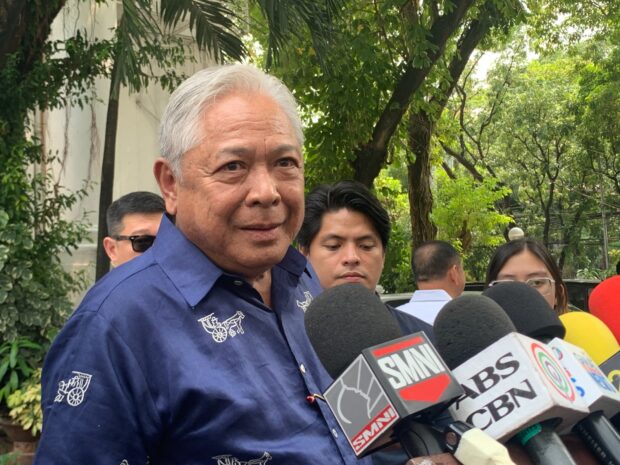PH quits seeking Chinese loan for Mindanao rail

Transportation Secretary Jaime Bautista (Photo by TEACH TORRES-TUPAS / INQUIRER.net)
MANILA, Philippines — The government is looking at new financing options for the Mindanao railway project after it backed out from loan negotiations with China, Transportation Secretary Jaime Bautista said on Wednesday.
The Department of Finance (DOF), in a letter to the Chinese Embassy dated Sept. 22, a copy of which was shown to the media by another transportation official, said the Philippine government “is no longer inclined to pursue the Chinese ODA [official development assistance] financing for the Phase 1-Tagum-Davao-Digos segment” of the railway project.
“Moving forward, we wish to inform you that the [Philippine government] remains open to holding project-related discussions and technical-level exchanges on any other pipeline projects under Chinese financing,” read the letter.
Asked if the move to drop the loan negotiations with China had something to do with Manila’s territorial dispute with Beijing on the West Philippine Sea, Bautista said: “I don’t think it is related.”
He said they were instead looking at government funds, ODA loans, and the public-private partnership (PPP) scheme to finally get the first railway project in Mindanao moving.
Article continues after this advertisementBautista said they were targeting to secure the financing for the hybrid passenger and freight line by the first quarter of next year.
Article continues after this advertisementInfrawatch PH, a public policy think tank, agreed that the Department of Transportation (DOTr) should find another financing partner for its big-ticket infrastructure projects.
“All indicative projects should now focus on partners which do not endanger our national interest,” Terry Ridon, the group’s convener, told the Inquirer on Wednesday.
Bautista noted that the Mindanao railway project was in the “process of design finalization” and the government was working on the right-of-way issue and eventual acquisition of the land.
The P83-billion rail project seeks to reduce travel time from Tagum in Davao del Norte to Digos in Davao del Sur to about an hour from 3.5 hours currently.
Designed to service up to 125,000 passengers a day, the rail line was approved as part of the previous Duterte administration’s ambitious “Build, Build, Build” program and was originally targeted to be up and running by 2024 to 2025.
On-off negotiations
It is one of three major railway projects whose loan negotiations with China Export Import Bank (Eximbank) were overtaken by the change in the country’s leadership last year.
Talks on Chinese funding for the three projects began in 2018 after these were approved by the National Economic and Development Authority (Neda).
In January last year, the contract for the P142-billion Philippine National Railways (PNR) South Long Haul project, also referred to as the PNR Bicol Express, was awarded to the joint venture of China Railway Group Ltd., China Railway No. 3 Engineering Group Co. Ltd., and China Railway Engineering Consulting Group Co. Ltd.
The contract for the construction of the P51-billion Subic-Clark railway project was earlier awarded to China Harbour Engineering Co. in December 2020. However, the P83-billion Tagum-Davao-Digos segment of the Mindanao project failed to proceed after China was unable to submit a shortlist of contractors for its design-build contract.
In 2021, the DOF informed China Eximbank that the submitted loan applications for the railway projects would be valid only until May 31, 2022, and would be automatically withdrawn if not approved “in deference to the incoming (Marcos) administration.”
Upon assuming office in July last year, President Ferdinand Marcos Jr. directed the DOTr to go back to the negotiating table to secure loan agreements for the three railway projects.
The following month, Bautista announced that during his first official meeting with Chinese Ambassador Huang Xilian on Aug. 11, they agreed to resume funding negotiations.
Still, the discussions did not prosper as fast as the government had expected, and only recently, PNR General Manager Jeremy Regino said they were also looking into other funding options for the South Long Haul project due to pending negotiations with China Eximbank.
A potential funding source is the Japan International Cooperation Agency (Jica), which is a partner of the DOTr in crafting the 30-year rail master plan covering the National Capital Region, Central Luzon, and Calabarzon.
Jica has pledged about 300 million yen, or P125.68 million, for this initiative.
Bautista stressed that the development of the country’s railway system must be accelerated for the benefit of the commuting public.
Other major projects in this sector include the North-South Commuter Railway (NSCR) system, the Metro Manila Subway and the Light Rail Transit Line 1 Cavite Extension Project.
The NSCR system has 35 stations spanning 28 local government units from Pampanga to Laguna. It is expected to serve more than a million passengers daily.
The subway project, which will benefit some 519,000 passengers a day once completed by 2028, is designed to have 17 stations linking Valenzuela and Pasay City.
The first segment of the LRT Cavite Extension project is expected to be operational by the fourth quarter of next year.
“These rail projects are integral to expanding trade, commerce, and mobility in their respective regions,” the transport chief said.